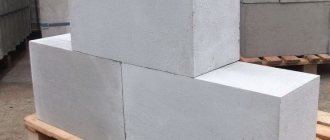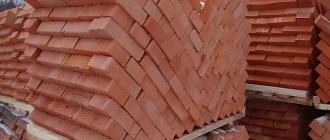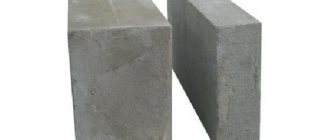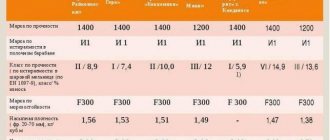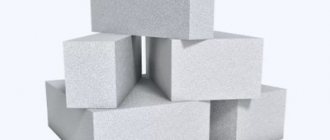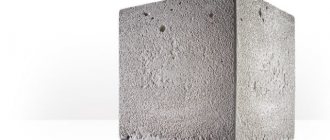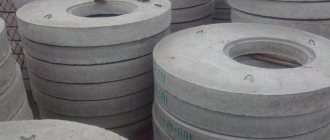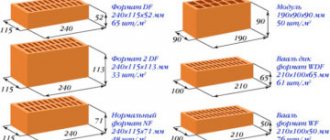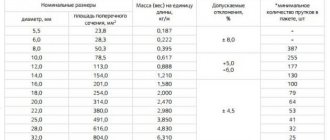Weight of a standard product according to density and size
Knowing the weight of a building material is often simply necessary. This is connected both with the transportation of cargo and its unloading; the mass of the block is important when planning the structure, or, more precisely, the type of future foundation.
That is why in this article we will touch on this topic and find out: how much does a foam block weigh? After all, the fact that it has a small mass is known to many, but not everyone can name the exact digital values.
What size foam block for home?
Standard sizes
Foam block is considered standard
600 mm long, 300 mm thick and 200 mm high.
This is the so-called standard foam block
, which is most often used for construction work. It is suitable for the construction of external and internal walls of a building.
Interesting materials:
How to cut out a dog bed? How to unscrew a brake pipe? How to print a3 on two a4 Word 2003? How to print part of a page from the Internet? How to print via AirPrint? How to print using a Canon printer? How to print a document from an iPhone to a printer? How to print a document from Android via USB? How to print a document from a laptop? How to print a document from your phone to a printer via Wi-Fi?
What affects the weight of a foam concrete block?
Do you know why the weight of foam blocks depends? Let's analyze.
Foam block, as already mentioned, is lightweight compared to other materials.
Comparison of foam block with other materials, including masonry mass
Here it is worth clarifying one important fact: the fact is that, in this case, we are not talking about the mass of one product, but about the weight contained in a unit of volume. That is, one ceramic brick is lighter than even a block with the lowest density, but at the same time, the weight of the masonry when constructing walls from this material will be much greater.
You may have already guessed that the point here is the density of the material, on which the weight of the product is directly dependent.
The foam block can be characterized by different density grades: from 300 to 1200 kg/m3. Moreover, products can have different sizes, which largely determines the weight of one foam block.
Note! The weight of the foam concrete block when changing the size will not affect the mass of the masonry, only the weight of the product itself. Simply put, if you are wondering how much a cube of foam block weighs, then only the density of the material is important to you. Regardless of the size, a cube of density brand products, for example, D400, will weigh the same.
At first glance, it may seem that there is nothing complicated in mass calculations. After all, the product of density and volume will ultimately answer the question about weight. But it is not so.
- Foam block, like many representatives of lightweight concrete, is hygroscopic . That is, it can absorb moisture relatively intensively, which will undoubtedly affect its mass. The figure is about 15%.
- There is such a thing as holiday humidity . In accordance with GOST, its value can reach 30% for products made from sand and 25% for products made from ash.
What is this connected with? The answer is simple. The fact is that blocks made on sand have a high thermal conductivity coefficient while maintaining the same density indicators, and when moistened, the thermal efficiency decreases even more.
Change in thermal conductivity in accordance with the applied silica component.
- It is also worth paying attention to the fact that the composition of the foam block affects its weight . First of all, this concerns the content of the silica component.
Some product classifications
When looking for an answer to the question of how much 1 foam block weighs, as you already understand, you should pay attention to the average density indicator. This indicator formed the basis of the classification and predetermined the scope of application of the products.
Varieties of products according to scope of application
And now in more detail:
- The least dense products are called thermal insulation and not by chance. The fact is that the value of this brand is only sufficient so that the blocks can withstand their own weight.
They are used for thermal insulation, since their thermal efficiency is relatively high. They have minimal weight. Most often, low-density foam concrete is used in liquid form.
Application of monolithic thermal insulating foam concrete
- A block characterized by a density of D500-900 is called structural and thermal insulation. Its weight can vary from 9 to 30 - 35 kg. Despite the higher strength values, the block can safely be called warm, because its thermal conductivity coefficient does not exceed 0.22 - 0.23 W*mS.
Structural and thermal insulation block
- Products called structural are the densest, and therefore the heaviest, of all the above types. Their thermal conductivity is also increased. Weight can reach 48 kg, and, taking into account operating humidity, even 50 - 51 kg.
Structural foam block, photo
Note! Foam blocks may also differ in manufacturing technology and composition. First of all, this applies to products made by hand and in a factory. Due to incorrect dosing of components and lack of technological control, for example, a block produced at home may turn out to be heavier while maintaining a low strength index.
Characteristics of foam blocks of various densities
Purpose of the block
Foam block, in accordance with its purpose, can be: wall and partition:
- The wall block, as a rule, is more durable, has larger dimensions and, accordingly, weight. This block is usually used in the construction of walls. Standard sizes are: 625 (600) * 300 * 200, 625 (600) * 300 * 250, 625 (600) * 400 * 250, 600 (625) * 500 * 300.
- Partition products are used in the construction of partitions. Their length and height are usually 600 (625) m and 250 mm, respectively. But the width is 80, 100, 90, 120, 150 mm.
Wall product
Septal block
Popular sizes of partition block
Of course, other sizes of products can be produced, and GOST does not prohibit this. However, over time, those block sizes that are in greatest demand have been established experimentally.
This, of course, is also explained by the design documentation, in which such products are most often found.
Weight of standard size blocks
Let’s use the table and visually study the dimensions and weight of the foam block.
Table 1. Foam blocks: dimensions and weight:
| Brand of product by density, D | Foam block weight 600x300x200 | Foam block weight 600x250x100 | Foam block weight 600x300x100 | Foam block weight 625x400x250 | Foam block weight 625x300x250 |
| D500 | About 20 kg | 8 kg | 8 kg | 25 - 27 kg | 22 – 24 kg |
| D800 | 28 – 35 kg | — | — | 36 – 39 kg | 29 – 34 kg |
| D600 | 22 - 26 kg | — | 16 kg | 30 – 32 kg | 26 – 28 kg |
| D1000 | 35 - 38 kg | — | — | 40 – 45 kg | 36 – 40 kg |
| D1200 | Up to 42 kg | — | — | 47 kg | Up to 45 kg |
Standard blocks
How to calculate?
The standard specific gravity of 1 m3 of foam concrete can be determined by the category to which it belongs. So, if the material is classified as D400, the mass is 1 cubic meter. m will be 436 kg. For the most massive category, D600, the spread will be from 450 to 900 kg. Foam concrete of group D1000 should weigh on average 1100 kg. But all these figures are achieved only with strict implementation of current standards.
In reality, even when the standards are strictly followed, there is a fairly large spread of values. Special measuring instruments help calculate the weight of one foam concrete block. But not every construction site has them. And therefore we must first of all start from the category of density.
This density is determined by how much per 1 cubic meter. m. account for:
Calculation of the volumetric weight of a foam block cube in kg, as a first approximation, is carried out simply by density (in this case, humidity is deliberately neglected). The idea is simple - multiply volume by density. But in practice, humidity is much more important than it seems. As water is absorbed, the total mass of the block increases noticeably, sometimes by 1/5. The volume itself is predictably calculated by multiplying the length by the height and width.
Suppose you need to find out how much a block with a conventional density of D600 weighs, the dimensions of which are 600x200x300. The total volume of this design is 0.036 cubic meters. m. As follows from the markings, 1 m3 of foam concrete has a mass of 0.6 tons. Therefore, the weight of the block will be 21 kg 600 g. But there is another nuance.
For 1 cu. m. volume accounts for 27.8 pcs. foam blocks with dimensions of 20x30x60 cm. If you take blocks of 10x30x60 cm, a little more than 55 products will fit in the same volume. Knowing the mass of 1 unit of product, you can calculate what the weight of a pallet or pallet loaded with foam concrete will be. The problem is that all these calculations do not take into account sorption moisture. And here the provisions of GOST 25485-89 come to the rescue. According to them, the level of sorption humidity in foam concrete can reach 8-15% (when creating a material based on sand).
If ash is used as a filler, the foam material can absorb an additional 12-22% of water. The exact indicator is determined by its initial humidity. Let the sorption humidity correspond to the lowest value (8%). In this case, for a product measuring 600x200x300 mm, it will give an additional weight of 1728. Conclusion: the total mass of the foam block will be no less than 23.328 kg.
Based on the maximum possible level of sorption humidity, the total mass will reach 26.352 kg. In order not to carry out calculations yourself, you need to seek advice from the manufacturer. At the same time, it is also worth carefully studying all official certificates. After all, the latest production technologies and differences in humidity levels can greatly affect the final result. The mass of blocks 600x300x200 mm is greater than that of bricks.
But due to the reduced density and reduction in the amount of cement for masonry, the overall pressure on the foundation is reduced. This is equally important for the wall and partition blocks. But the area of application significantly affects the weight characteristics of foam blocks. Thus, thermal insulation structures D300-D500 have a mass of 12-19 kg. And the structural elements D600-D900 have the least weight of 23, the most of 36 kg.
The heaviest building parts with dimensions of 600x300x200 weigh 40-47 kg. The average weight of the septum product is 21 kg. It should be taken into account that, according to Russian GOST, it is categorically unacceptable to produce foam blocks longer than 0.6 m. Thermal insulating foam block of wall design has a mass of 11.6-19.5 kg. If we consider the option of a partition heat-insulating product measuring 10x30x60 cm, its mass turns out to be record low - only from 5.8 to 9.7 kg.
Calculates mass independently
Now it's time to learn how to do calculations. In fact, there is nothing difficult about this and anyone can cope with this task.
We take into account the sorption mass
How to correctly calculate the weight of a block under operating or holiday humidity conditions?
We make a calculation
The instructions are extremely simple:
- The first step is to calculate the volume of one product. Let its size be 625*400*300. 0.625*0.4*0.3=0.075 m3.
- Now we multiply the volume and density of the block, let’s say it is equal to D400. 0.075*400=30 kg.
- Next, we need to find out which raw material acted as the silica component. There can be 2 options: ash or sand. If it is sand, then the humidity level is usually about 15-20%. If it is ash, then slightly less, about 12-15%.
- Next, we calculate the mass of moisture that the product could absorb.
- To do this, you need to multiply the minimum humidity indicator and the mass of the dry block: 30 * 15% = 4.5 kg.
- Finally, we add up the results: 4.5 + 30 = 34.5 kg. This is the mass of the block taking into account sorption moisture.
Product cube weight
If we talk about the weight of a cube of foam blocks, then, in this case, everything is even simpler. We have already said above that the net weight of a product in a dry state is determined by the formula: volume * density. That is, if we want to know the weight of a cubic meter, then we don’t have to count anything.
1 m3 of foam block, with a density of 500 kg/m3, weighs 500 kg, with a density of 1000 kg/m3 - 1000 kg, and so on.
The density of the foam concrete block can vary from 300 to 1200 kg/m3. This means that a cube of products cannot weigh more than 1200 kg, again, in a dry state.
Number of blocks of different sizes in a cube
Weight of one pallet with products
- In order to calculate the weight of one pallet of products, we need to find out the number of blocks that are located in the pallet.
- Only then will we be able to determine the mass by adding the additional weight of the pallet to the weight of the blocks.
- A plastic pallet can weigh from 10 to 15 kg, and a wooden pallet - up to 30 kg.
- Different manufacturers have different numbers of blocks that fit on a pallet.
- Let's assume that we have 2.0 m3 of blocks on a pallet, measuring 625*400*250.
- 1 such block weighs: 0.625*0.4*0.25=0.0625 m3; 0.0625*500=31.25; 2/0.0625=32 pieces. 32*31.25=1000 kg. 1000 kg + 30 kg = 1030 kg.
Pallets with foam blocks
The video in this article: “Foam blocks: price, weight and dimensions” contains a lot of useful information about the products.
Types of gas blocks
For construction, mainly ordinary ordinary blocks of a standard shape in the form of a parallelepiped, with rectangular sides, are used. However, to cover openings and make reinforcing reinforced concrete belts, U-shaped blocks are used, which in cross section repeat the shape of the letter U.
Rectangular
Rectangular products are made from a mixture of quartz sand and cement using a gas generator. The hardened mass is cut into blocks of a given size and dried either under natural conditions or in autoclaves under the influence of hot steam. During the molding process, tongue-and-groove locks and hand grips can be made at the ends of the products.
U-shaped
U-blocks are made from ordinary blocks by sawing out the middle part along the upper bed edge. As a result, an ordinary parallelepiped takes the shape of a tray. Such products are used in the form of permanent formwork when constructing beams and lintels. The thickness of the tray walls varies from approximately 50 to 70 mm.
Specific gravity of foam block, its properties and weight calculations
Foam concrete is a mechanically strong lightweight building material. During the production process, air pores are formed in the foamed concrete mixture, which, when solidified, provide lightness and a good degree of heat retention. Most often, foam concrete blocks are used as: the basis for the construction of load-bearing walls, partitions and insulation of walls, roofs and floors.
Manufacturers of building materials are trying to achieve the ideal result, which is how new varieties of foam concrete appear.
How to calculate
If it is necessary to calculate the weight of 1 m3 of foam block, you need to take into account its dimensions and density. There are standard mass values accepted for blocks of a certain density and size.
Standard weight of foam blocks measuring 600x300x200 millimeters of popular brands:
- D500 - at 0% porosity the weight is 23.4 kilograms, if the porosity is 20% then 18.75 kilograms, 50% - 11.7 kilograms.
- D600 - at 0% porosity the weight is 27.72 kilograms, at 20% 22.18, if the porosity is 50%, then the weight is 13.86 kilograms.
Specific gravity according to standards is determined by brand: a cubic meter of material D400 weighs about 436 kilograms, D600 - from 450 to 900 kilograms, D1000 on average per cubic meter should weigh about 1100 kilograms. These figures are relevant provided that all established standards are strictly observed. The weight and density of foam concrete are determined by its composition and proportions of sand, cement, water, and foaming agent.
The volumetric weight of a cubic meter of foam concrete in kilograms can be calculated by density: multiply the volume by the density. But in this case, the humidity indicator, which is very important, is not taken into account. Indeed, as a certain volume of water is absorbed, the block increases its weight, sometimes by a significant amount. The volume of a block is calculated by multiplying the height and width by the length.
So, for example, if you need to find out the weight of a D600 density block measuring 600x200x300 millimeters, then the total volume of the structure is 0.036 cubic meters (the value in meters is multiplied by 0.6x0.2x0.3). The marking says that a cubic meter of foam block weighs 600 kilograms. Thus, the weight of one block will be: 0.036 x 600 = 21.6 kilograms.
But in all these calculations the sorption moisture content of the material is not taken into account. Thus, according to GOST 25485-89, the level of sorption moisture of foam concrete can be equal to 8-15% when it is produced using sand, and it can additionally absorb up to 22% when using ash as a filler.
If we take it as a fact that sorption humidity is at a minimum (8%), then another 1,728 kilograms must be added to the weight of a product with dimensions of 600x200x300. Thus, the total mass of the foam block will be at least 23.328 kilograms. If the sorption humidity is maximum, then the mass of the block will be 26.352 kilograms.
Due to the fact that foam blocks have a lower density and weight compared to traditional materials, and also due to the reduction in the volume of masonry mortar, the total weight of pressure on the base of the building is significantly reduced. This is important for both the partition and wall blocks. The scope of application of foam blocks significantly influences the characteristics: structural grades D600-900 weigh 23-36 kilograms, insulating grades D300-500 - 12-19 kilograms.
The densest and heaviest blocks measuring 600x300x200 millimeters can weigh 40-47 kilograms. The average weight of the septum block is 21 kilograms. GOST prohibits the production of blocks longer than 600 centimeters. Wall blocks for thermal insulation weigh 11.6-19.5 kilograms, partition thermal insulation blocks with dimensions of 100x300x600 millimeters weigh the least (5.8-9.7 kilograms).
Once again it is worth mentioning the need for water correction when performing calculations. It is especially important to consider the value for grades D1000-1200: the dry weight of the blocks is 47 kilograms, but when saturated with moisture, the elements can weigh up to 50 kilograms. For one block this is not much, but when taking into account a large number of elements during transportation and calculating the load on the foundation, the values turn out to be significant.
Being able to calculate and know how much a foam block weighs is very important both at the stage of implementing calculations in the project and during the construction of the building. Only taking into account all indicators and adhering to technology will allow you to obtain a reliable, strong and durable structure.
